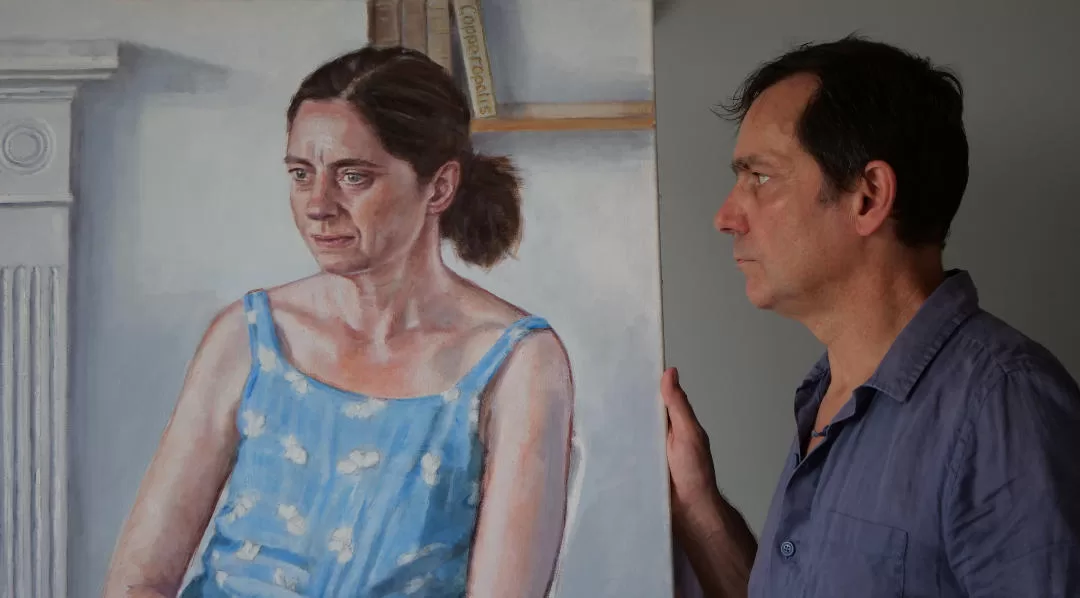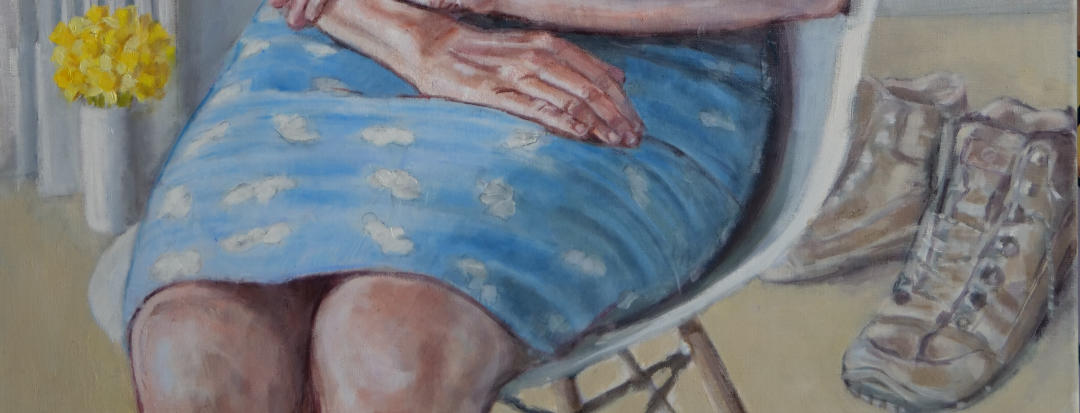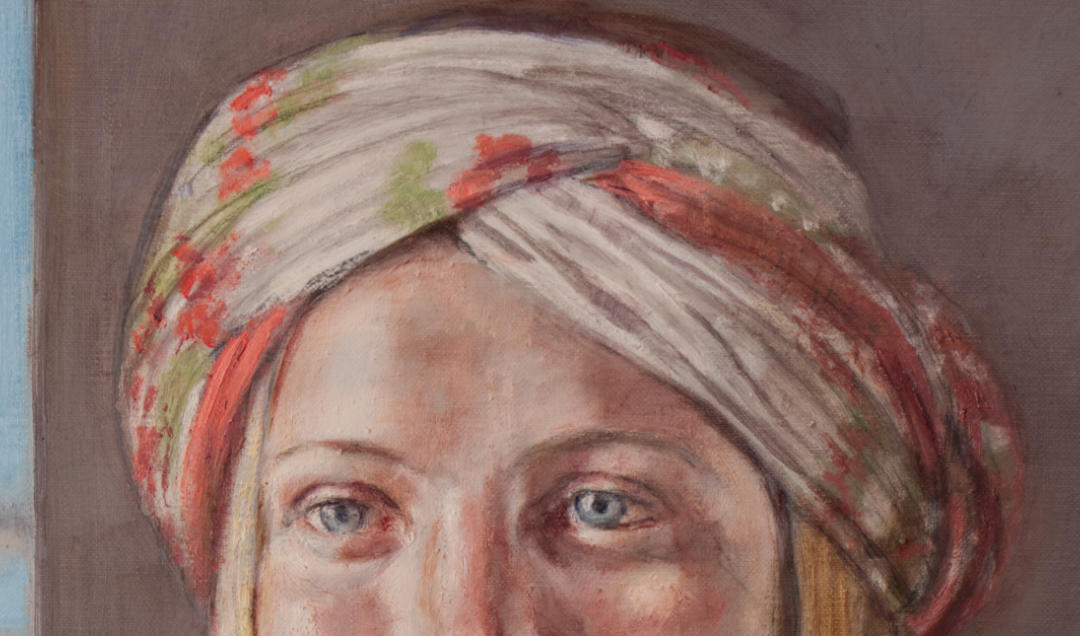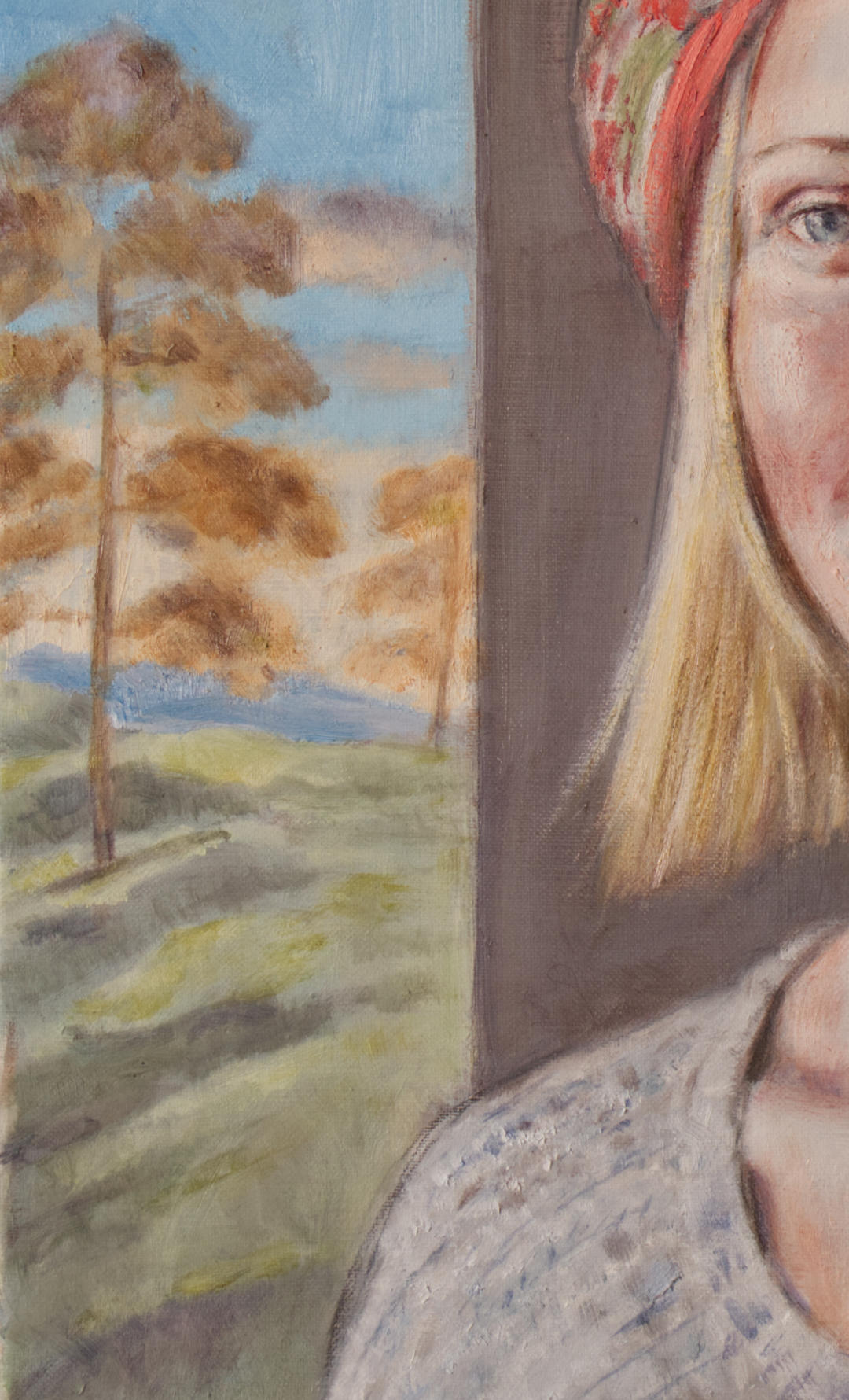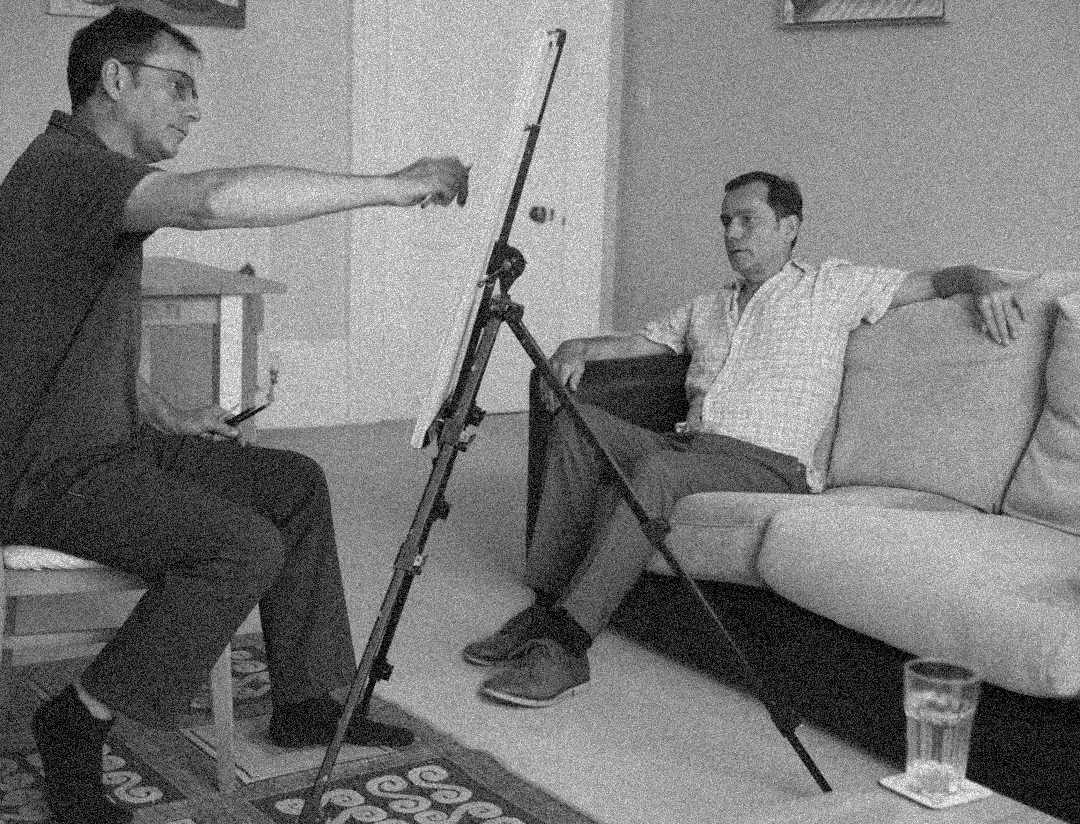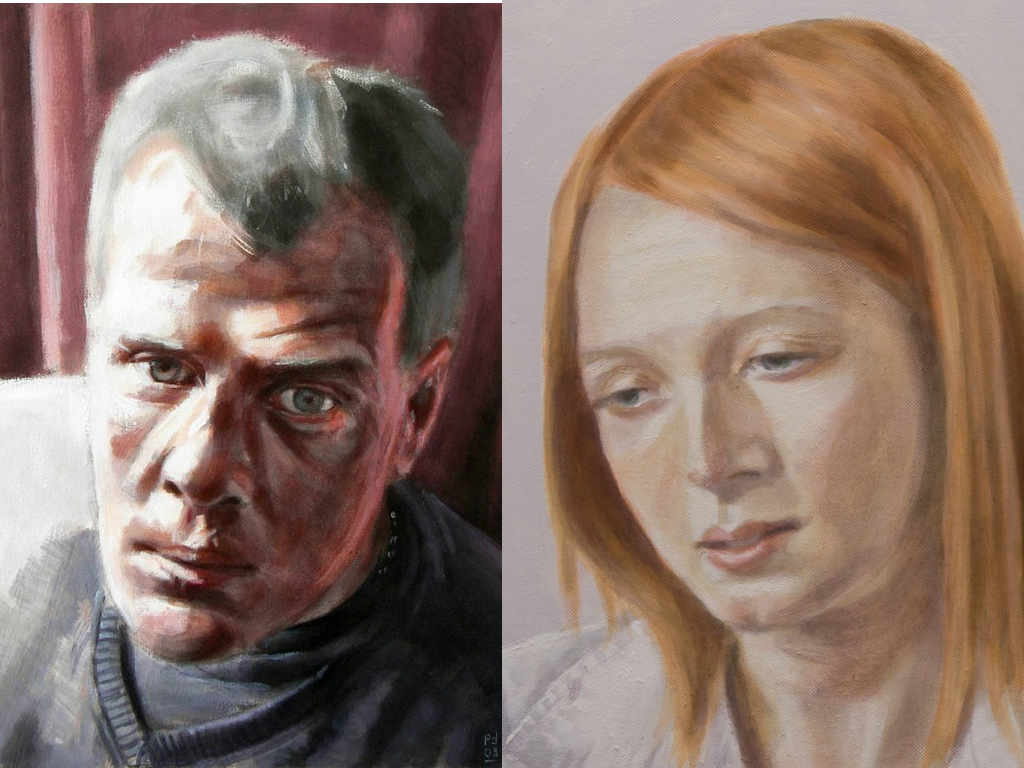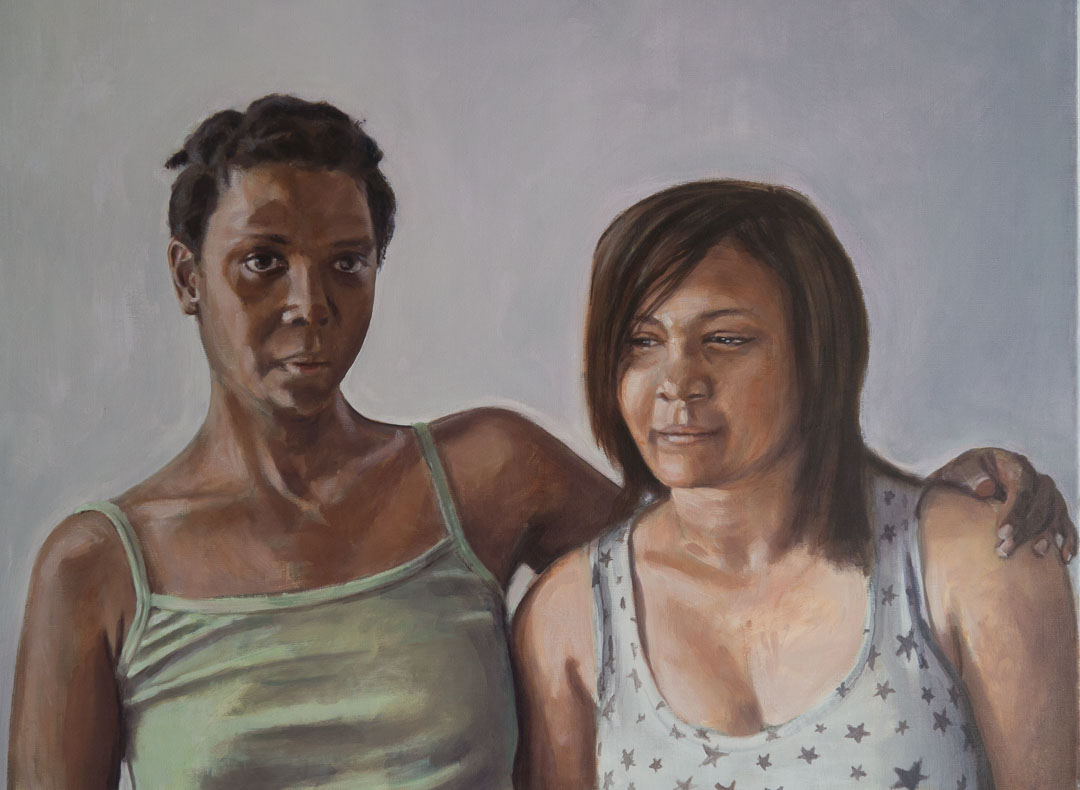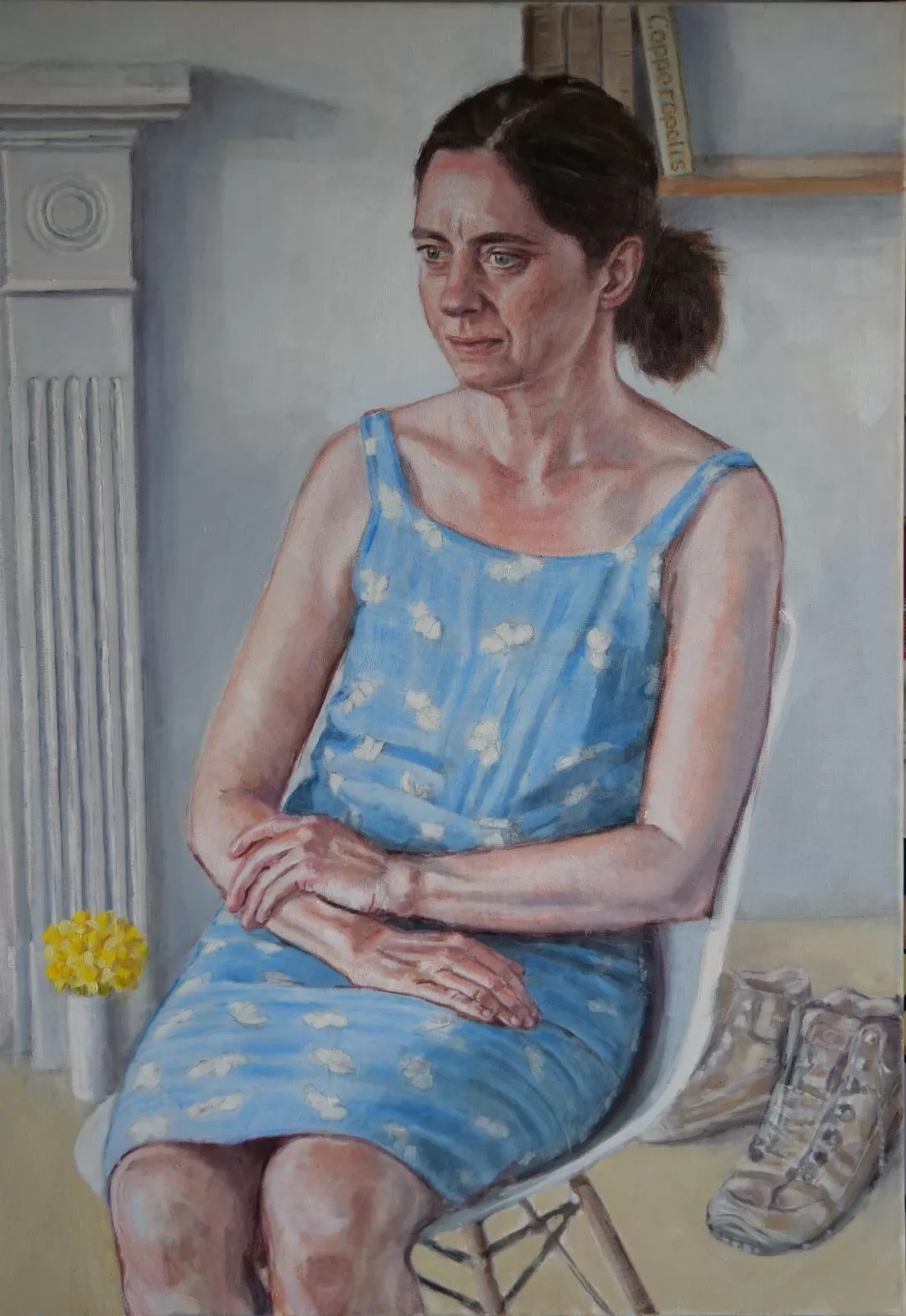
I have collected some case studies of recent portrait paintings, detailing the decisions that had to be made in planning each painting. I hope they might be useful to anyone thinking about having their own portrait painted.
Portrait Case Study 1. The Blue Dress
- Size and pose: This is quite a large portrait, at over 100cm tall. Given that we quickly agreed on a large canvas, it was then a choice of choosing between a full length or 3/4 length pose. We worked through a variety of standing and seated poses, finally agreeing that this seated position looked best. We paid great attention to the placement of the hands – trying to avoid them looking awkward, while also looking interesting in the final painting. Apart from adding greater visual impact, this size canvas does allow for working in greater detail on the whole figure and on the clothing.

- Style and clothing: We were limited by the chosen date for the sitting being a blazingly hot summers day, so a loose summer dress seemed the most comfortable option. It wasn’t the first dress pulled from her wardrobe. We considered quite a few options, and in the end agreed that this dress looked nice on her and would add some interest to the painting.
- Setting: Ordinarily I liked to have sitters pose in their home environment. Apart from being more comfortable, the decoration and furnishing of a room often says something about the sitter. In this particular case the sitter had just sold their old home and was staying in rented accommodation, awaiting a move to their new home. So this bland Airbnb flat certainly didn’t say much about the sitter, but it was a suitably bright and blank backdrop. I chose to include some of the fire surround just to add some visual interest, and to help set the sitter in space.

- Props: The items in the background (shoes, book, flowers) were added later, and weren’t part of the original brief. As I worked on the painting, I felt that there was a lot of dead space in the background that wasn’t doing anything. I also was not fully aware during the sitting what a pivotal time this was in the sitter’s life, and I felt I should include something (spring bulbs) to suggest the fresh start the sitter was experiencing. The boots and book are indicative of her great interests. I could have thrown in lots more, but I did not want the props to distract from the figure.
If you have any questions about commissioning your own portrait, please don’t hesitate to get in touch with me. My email is on the Contact page
Portrait Case Study 2. Renaissance Garden

This is not actually a commission, but was painted as a portfolio piece – a painting that I could show to prospective customers and take along to art fares. In the event, it was snapped up by a collector shortly after I finished it, so now I only have the photos to share with you
- Canvas Size: I chose a 50cm x 40cm linen canvas for this painting before I even started. It’s quite common to start a commission with a decision about the canvas size. It might be to fit in with your budget (larger paintings will incur more costs), but more often it’s because most people have limited space to display artwork.
This particular linen has a very nice surface for portraits; although the weave is still visible, it’s less intrusive than cotton canvas. The smoother surface allows for more detailed work. - Pose: I worked through quite a few different poses with the sitter. She had a wonderful calm demeanour about her, which I wanted to capture in this painting. Having already decided on the canvas size, I was limited in my selection of poses. A full body pose would have meant her face would have been quite small on the canvas. I find this size ideal for a head and shoulders portrait, being large enough that I can introduce quite a lot of detail in the face. We went through different poses with arms crossed, or the model sitting. In the end I chose this standing pose. The model had such excellent posture, and that wonderful poise, that I wanted to try and capture it with the simplest of poses.

- Style and clothing: I asked the model to select her own clothing, giving consideration to how she wanted to be portrayed. She arrived wearing a colourful headscarf and loose knit jumper, which suited her well. The jumper provided a nice contrast in textures, which worked well in the finished painting.

- Background: I initially planned this portrait with just a plain background, but I quickly realised there was a timeless quality about this model, which got me thinking about Renaissance portraits; where they might sometimes introduce a section of landscape in one of the top corners. This was a useful device to add depth and perspective to the composition, while also adding colour and visual interest to the painting. I was more interested in the latter, and how a serene vista would complement the model’s calm manner. I also wanted to demonstrate how alternative backgrounds can be easily introduced into a commissioned portrait.
- Props: No need for props with this portrait. The smaller canvas didn’t lend itself to being cluttered with objects. With similar commissions of this size the sitter has asked that they be painted wearing a particular piece of jewellery, which was of sentimental value.
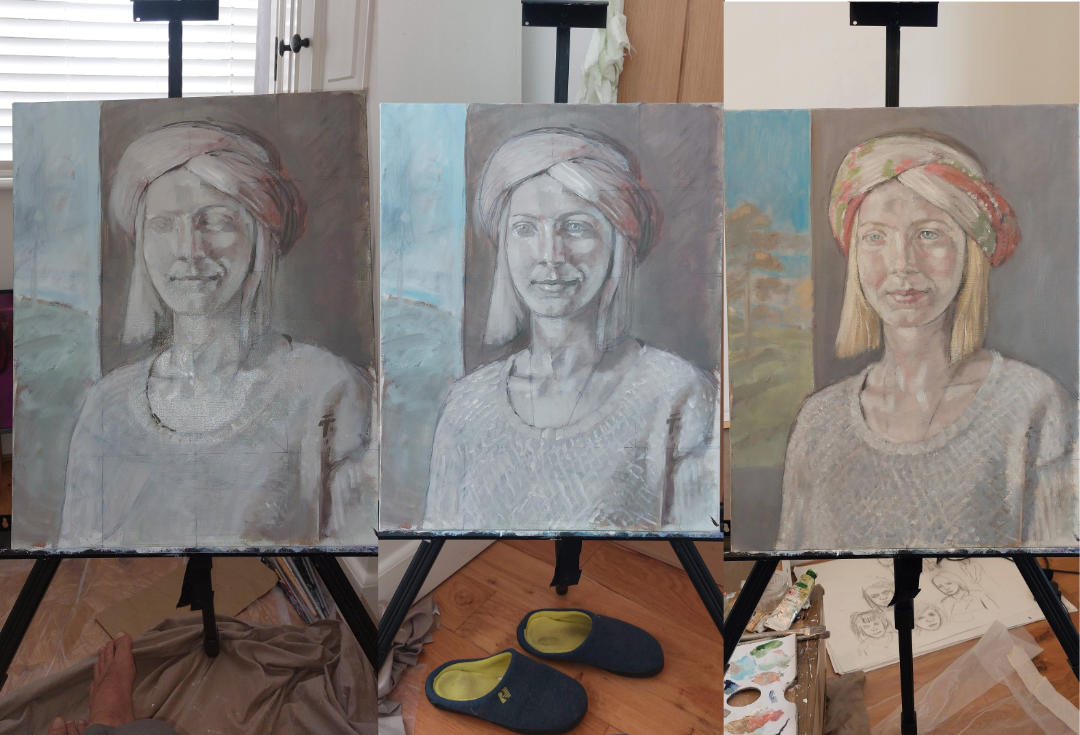
Painting technique – Glazes and underpainting
The photo above shows the painting at three different stages. I had already worked out the composition on paper, with preparatory drawings. The underpainting is painted with a monochrome or very restricted palette. Once I was happy the tonal values were correct, I introduced colour into my palette. The final photo above shows the painting just before I add the colour glazes. It’s a traditional technique can add a wonderful luminosity to the highlights, and a depth of colour to the shadows that simply cannot be achieved with other techniques.
I have written a blog post about my use of glazes. You can find it here: Glazes and Underpainting
Portrait Case Study 3. The Dancer

This was a challenging commission. It taught me a lot about ballet, and also about specific problems in painting “action” poses. I was approached by a ballet teacher who wanted a portrait of herself in a recognisable dance pose. Being a lifelong admirer of Degas’ wonderful paintings of ballet dancers (here’s an example at the Met), it was a commission I couldn’t refuse.
I was concerned that my studio would not be big enough. Although fine for portraits, I felt it might feel cramped if she started throwing her arms and legs around. Despite my suggestion to have the sitting at her dance studio, she preferred to come to my studio.

Problems holding a pose.
The first problem I encountered was that it proved difficult to hold any dance pose long enough for me to produce a useful drawing. Gestural charcoal sketches were okay, but the more detailed drawings I like to produce were not possible, and the sitting became quite a challenge for the both of us. I can see why Degas favoured pastels.
As soon as I had enough sketches, I suggested my client should run through her repertoire of ballet poses, and I would start taking photos. She looked through the photos every now and again, and we would adjust the poses accordingly.
Apart from the different poses, we also tried different outfits. In the beginning the tutu was my least favourite outfit and I couldn’t see it making it to the final painting. By the end of the sitting we had lots of photos of various ballet poses carried out in three different outfits. My client checked through them, pointing out any where the pose was not up to standard, and then I undertook to work up some sketches from the remaining photos, offering some alternative layouts.

A choice between two poses and outfits
I couldn’t find the original sketches, but did manage to find photos of these later oil sketches. We had already eliminated alternative poses, and I offered my client two slight variations of this pose. Although I hadn’t been keen on the tutu at first, by this stage I felt it looked the better outfit, and made for a more balanced composition. Also the pose on the left looks that little bit more dynamic.
What did I learn? Ballet instructors are very demanding about their dance positions being spot on. I got into trouble with some wonky arms in my first sketches. Second, although I’m very happy with how the painting turned out, I still feel that it would have added extra visual interest if it was set in a dance studio. Finally, if I’m presented with a similar dance challenge in future, I would forgo my usual preparatory sketches, and would instead video the sitting while taking photos. I think that would be a more useful record than my charcoal sketches. I have started to use video even with my traditional portrait paintings (especially when the sitter can’t pose in person), as it can sometimes give a better sense of what the sitter really looks like.
If this article has given you the inspiration to commission your own painting, don’t hesitate to get in touch with me – use the email address on my Contact Page.

